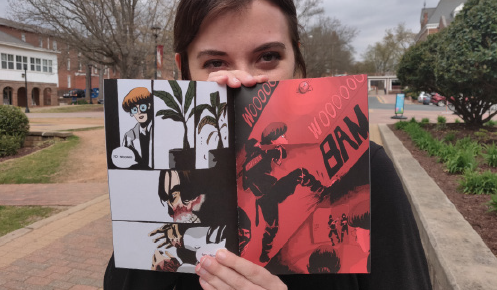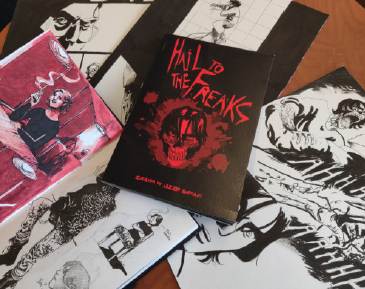“Star Wars” sparked her passion for drawing. Ten years later, senior illustration major Lizzie Shepard is making her dream come true with her original comic “Hail to the Freaks.”
She did the entire layout, panelwork and coloring for the first issue. The original hand-drawn pages were monochromatic with black ink; the pages were digitally colored for the final product.
The illustration major self-published “Hail to the Freaks” for a course called Sequential Art. While Shepard said she enjoyed the process, she encountered some challenges. The websites she utilized took “a long time” to get the final product out to her.
“I would rather be part of a company that publishes the stuff for me… I don’t want to do Marvel or DC because I don’t want to be third-wheeled. I’m thinking about Dark Horse,” Shepard said.
Dark Horse Comics is an American comic book and manga publisher, best known for works like “Hellboy” and Frank Miller’s “Sin City.”
Shepard said she wants to get involved in the film or comic book industry following graduation in May. Film concept art, production design, set design and costume design are areas of her interest. One of her final career goals include becoming an art director.
Inspiration for a career involving illustration and drawing came from watching “Star Wars” behind-the-scenes extras. Shepard called the artwork behind “Star Wars” beautiful.
“I always watched behind-the-scenes of how they made stuff in the movie. Eden McKeg… he did all the costumes for the prequels, at least Queen Amidala’s clothes. I loved seeing how he drew all that. It really fascinates me,” she said.
The self-taught artist was also influenced by animated works, including Disney and Studio Ghibli. Studio Ghibli is a Japanese anime studio known for its distinct art style, fantastic themes and emotional plots and storytelling. A few of their notable works include “Princess Mononoke,” “My Neighbor Totoro,” and “Howl’s Moving Castle.”
“Seeing ‘Spirited Away’ for the first time really blew my mind, because it was different,” Shepard said. “When I was seven, I started learning to draw when I watched ‘Spirited Away,’” she said. “I would draw the characters all the time. Now I draw things I like, like ‘Harry Potter’ or ‘Star Wars.’”
Shepard decided on the film and comic book industry as potential career paths in middle school, wanting “to be part of something bigger than [her]self” and “inspire other artists.”
“I moved around a lot, and I had friends but they never really last long. Usually it was me, my notebook and movies I watched. That’s why I’m so attached to film,” she said. “I want to be that cool comic book artist no one’s ever heard about until someone else gets inspired by me.”
Inspiration behind “Hail to the Freaks”
The Berlin Wall was the result of Germany being carved into four occupation zones after the end of World War II in 1945. Half of Germany went to the United States, France and Great Britain (the Allies), and the other half was occupied by the Soviet Union. These zones were called West and East Germany respectively.
“Hail to the Freaks’” setting is based in Germany during communist occupation and the conflict between East and West Germany. Shepard said she wanted to diverge from the traditional comic book premise of superheroes in metropolitan cities, like New York. She also said she was a history enthusiast.
The 2009 movie “Push,” starring Chris Evans and Dakota Fanning, inspired Shepard to take a more realistic approach to “Hail to the Freaks.” She affectionately referred to the movie as her “Holy Bible” for narrative and thematic structure.
“They are real people with real struggles with their power. It was more realistic. The average person with strange abilities,” Shepard said. She developed her characters from brainstorming sessions with a friend.
The research for “Hail to the Freaks” included the lifestyle of the late 80s and 90s of West and East Germans, including housing, clothing, struggles and social norms.
“I watched a lot of documentaries about the lifestyle of East and West Germans,” Shepard said. “People try to escape all the time, and people got killed for it. It was a very big problem. I observed the clothes and music was a big component.”
The illustration major said she loved listening to music like Nirvana, and the music helped her understand the world as she drew her comics and panels.
“It has a very Grunge-y feel, which is reflected in the artwork… the aesthetic. Splashed inks and gritty,” she said.
Synopsis of “Hail to the Freaks”
The story of “Hail to the Freaks” begins with the Berlin Wall falling and the divided German capital.
“A disease happened around the world, and it’s affecting everyone; it’s changing their DNA. People in the West are more acceptable about it… People use it within their jobs, in their companies. It’s very natural. But in the Eastern side with communism, that’s a big no-no,”Shepard said.
A company called IPCO gathered people with powers, molding them into weapons for Soviet use. Biotechnology is a recurring theme and motif in the comic.
“Micah is the son of one of the co-partners of the facility,” Shepard said. “He has the power to absorb energy. The company fears that he can absorb other people’s powers as well, and he can. They shut him off from everyone else, and they are slowly killing him off.”
Micah is featured on the cover of “Hail to the Freaks,” and the skeletal half of his lower face is the result of his torture.
“He can make himself look normal, he just has to constantly absorb things, whether it’s nature, people or matter,” she said.
Shepard said she always draws Micah with a cigarette in his mouth, because inhaling cigarette smoke counts as the matter he can break down. When the Berlin Wall falls, many people break out of prison or escape from the IPCO facility to reunite with their families.
“It’s like this big revolt… People in West Germany didn’t know people were being kidnapped in East Germany,” Shepard said.
Shepard’s advice to people interested in pursuing a career in illustration: “Just do it.”
“When I was a kid, I felt like it would never happen. A lot of art people are quiet about their work,” she said. “I was for the longest time. Don’t be afraid to tell people about it. That’s how people got interested when I was growing up. I didn’t think I was going to do it, but here I am.”
Shepard regularly posts her drawings, doodles and even pages for her second issue of “Hail to the Freaks” on her Instagram, @idgylizzie.





